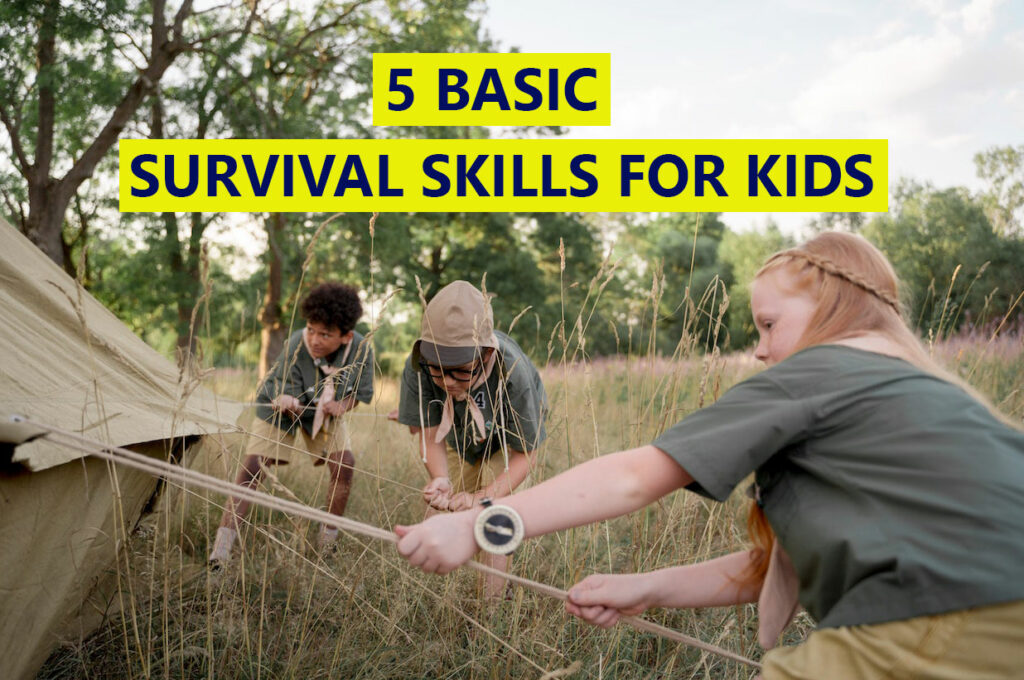We tend to be very protective of our children! Equipping our children with basic survival skills makes the world a much less scary place for them! Teaching children basic survival skills increases their self-confidence, empowers them, and helps them expand their horizons to excel in many spheres of life!
However, while teaching them survival skills, you should ensure that they embrace the fun side of learning, as the easiest skills for a child to master are the ones they don’t know they are learning!

For teaching kids the skills, you do not have to go out in the wild; these simple plans/lessons can be easily conducted in a local park or a ground or even in your backyard! Following are the five basic survival skills for kids
Risk assessment
This is the most basic yet crucial survival skill for young kids. People are under the assumption that risk assessment means ‘common sense.’ However, it is important to eradicate this misconception that people harbor in their minds.

Children tend to imitate and learn from us! Our collective endeavor is to create more opportunities for the children to engage in various risk assessment exercises. For example, take them on a walk with you in the park and also invite them to point out all the potential risks and hazards involved. Encourage them to share what mitigating actions are needed to combat the issues/risks.
This specific exercise gives kids a chance to apply their judgment skills. Thus, they will know about a similar situation when they go camping.
Knot tying
In many situations, knot-tying is one of the most important survival skills! Knot tying holds great importance in camping or other related outdoor activities. This is an essential skill that every camper should know. It makes a huge difference when it comes to your safety and comfort.

Kids grasp everything faster, and with consistent practice, any person can learn the basics of knot tying quickly. Knot tying can be used for many tasks, such as setting up a tent, tying a splint, or tying down a tarp.
A simple knot-tying activity enhances kids’ fine and gross motor skills, such as eye-hand coordination. Initially, you can make them tie their shoelaces or ask them to tie ribbons. Young children should know the importance of tying knots in camping.
The different types of knots help keep your children safe and make their camping experiences much more enjoyable. Children should learn to tie different types of knots, such as the taut line hitch, clove hitch, and bowline knot. These are some of the most common knots used for camping.
Treasure hunt and map reading
Map reading is important, and the main goal is to exercise your kids to use a map as well as a compass to pinpoint their location and find their way to their desired destination. To demonstrate to your kids and teach them how to use a map, you will need a compass and a map.

First, explain to the kids the cardinal points on the compass. Teach them how the arrow on the compass always points north. After familiarizing them with the cardinal points, take out the map and show them the compass route, which indicates the same cardinal directions on the map.
First, ask them to locate the easy landmarks such as your house, a body of water, or a road/avenue. After then, kids attain a good grip on identifying the cardinal directions and learn how to use the map and compass together; ask them to find north on their compass.
Fore checking if they have understood you can see if they can travel from one landmark to another using a compass and a map!
Shelter building (Tent building)
Shelter building or building a tent can be a lot of fun for children. This task can be much simpler if the children are able to grasp and do some simple essential knots. There are many ways to build a tent. You can teach them by building a simple kid’s tent.

While building a kid’s tent, tighten a string between two sturdy points; after that, throw a sheet over the points in a particular frame setup. After adding a few pillows below, you are good to go! While building this tent, ask the kid to keenly observe and then follow accordingly!
Shelter building or tent building affects the problem-solving skills of your kid and also compels him/her to use their imagination. Your child will understand cooperation and negotiation while building a tent.
Building a tent is indeed teamwork! It is not a single person’s job. Your kid is exposed to social skills while tent building is taking place!
First aid
Last but not least, first aid training is an extremely vital life skill, and it provides kids with a pivotal knowledge base for dealing with medical emergencies they are subjected to. As parents, it is your responsibility to equip your child with skills and good judgment for keeping themselves and everyone around them safe!

You should educate them on prevention and preparedness so that they are able to take care of themselves as well as the ones that are around them while hiking/camping.
Basic things like using a bandage, applying an ointment on the wound, or applying a disinfectant on a wounded area are some important things you should teach your child. When you teach them these things, you automatically make them self-reliant and independent.
Final words
We live in a firm grasp of technology, and in our modern age of technology, the amount of time our kids spend outside is decreasing to a great extent. Going out and actively participating in any outdoor activity is getting replaced by watching TV or playing video games.
If you intrigue your kids and develop an eagerness in them for learning these basic survival skills, you will be able to automatically shift their focus and encourage them to do something productive.
Kids often tend to miss out on some of the most valuable learning experiences, and if they are not exposed to wildlife, they will be lagging behind and lack the skills and knowledge to protect themselves!



GIPHY App Key not set. Please check settings